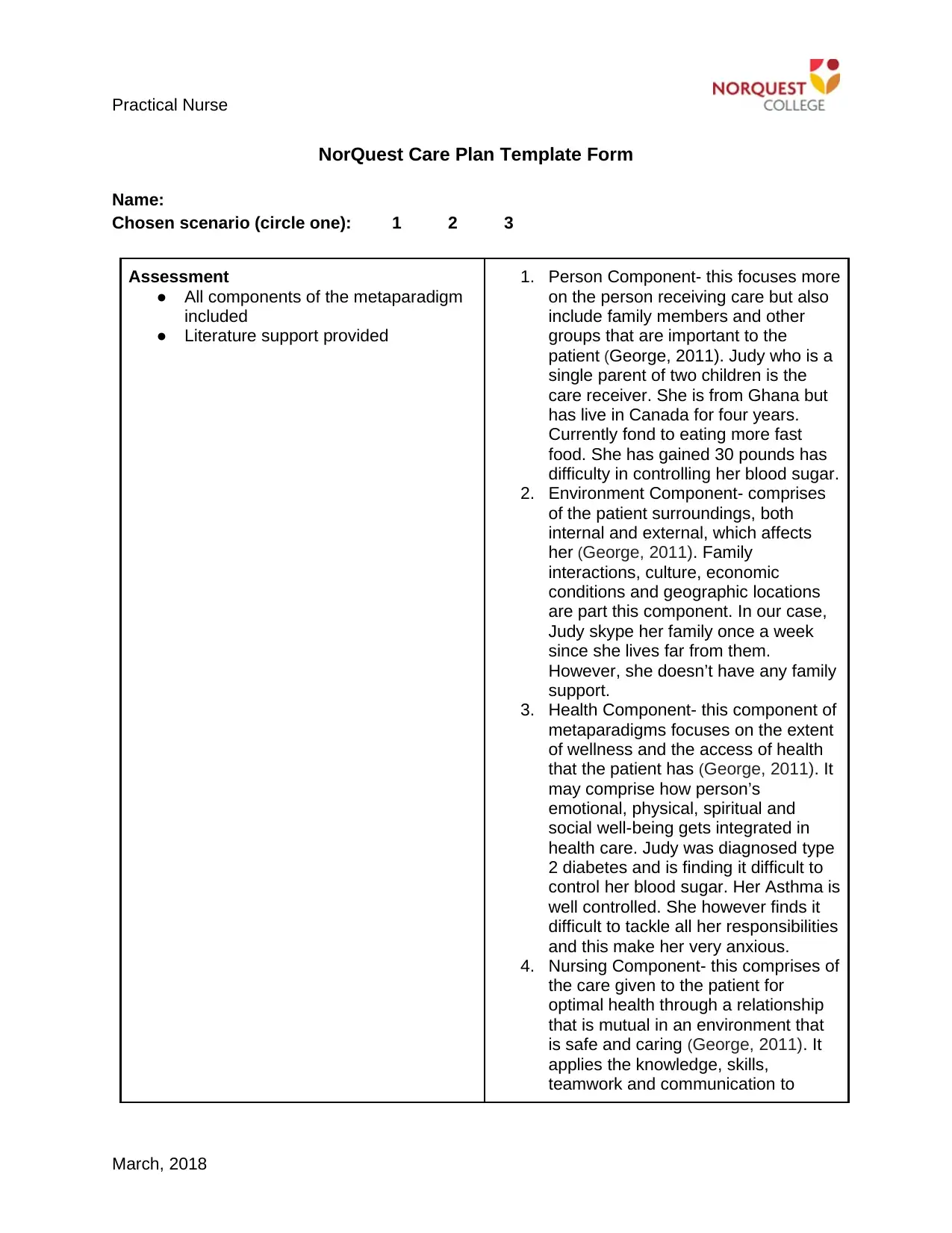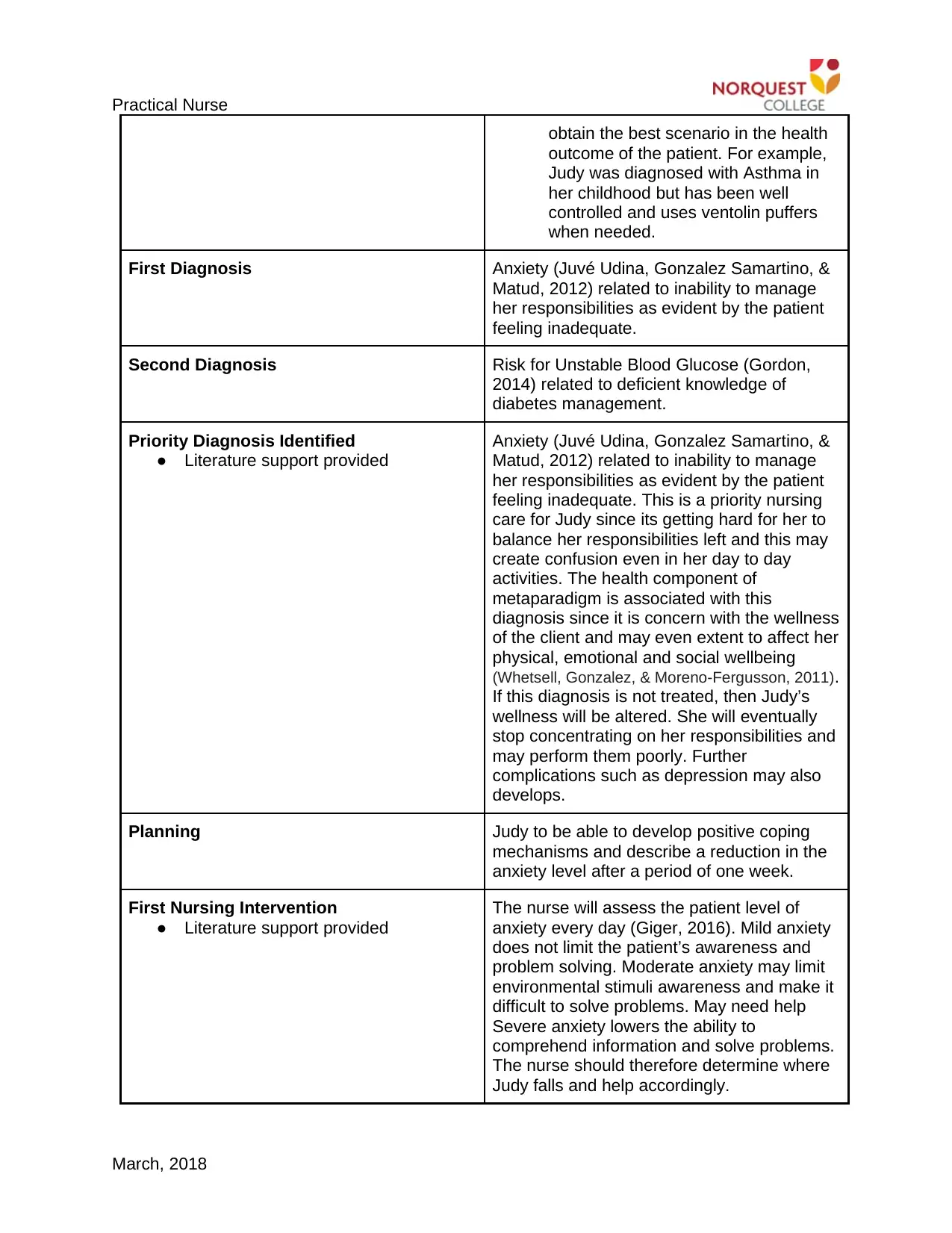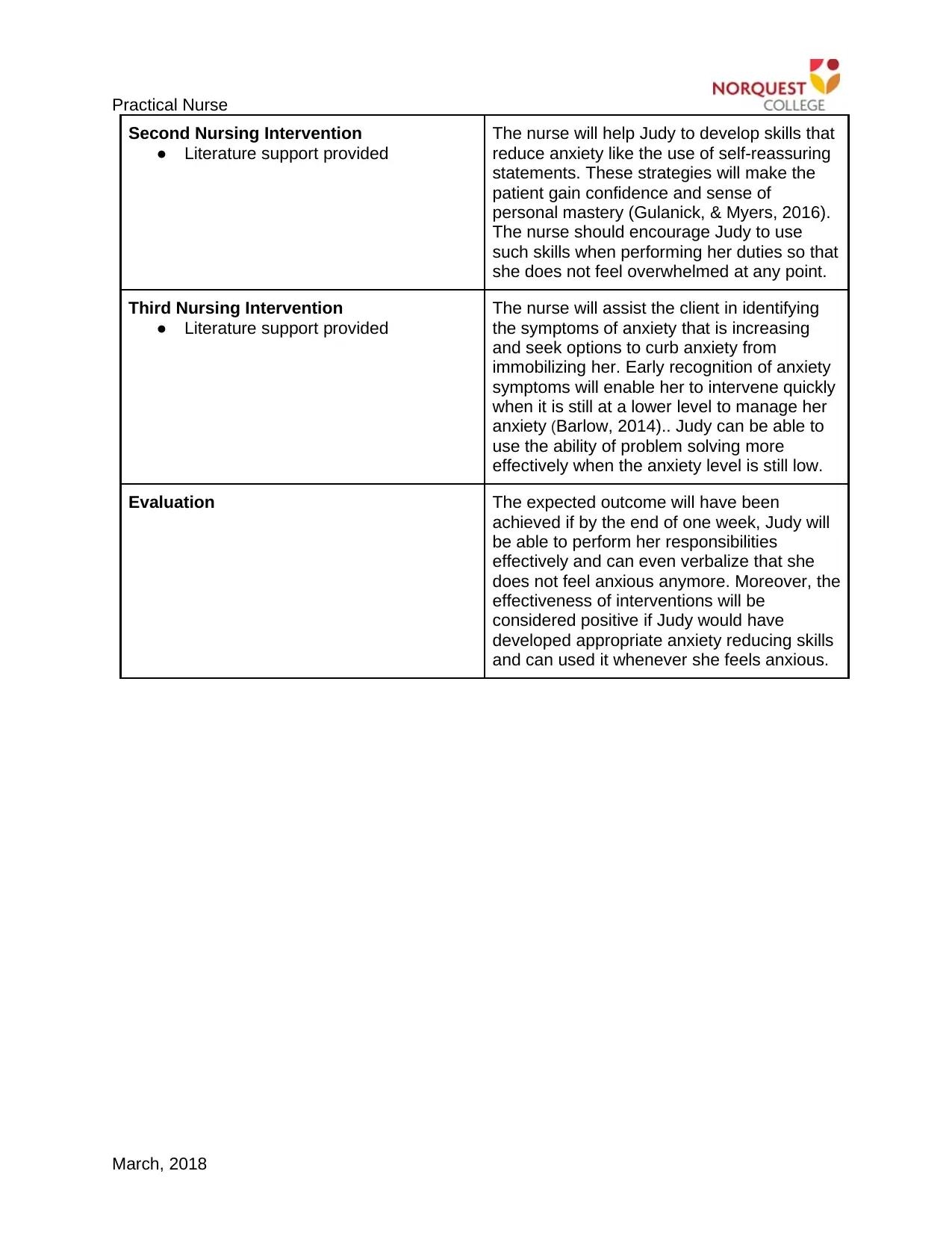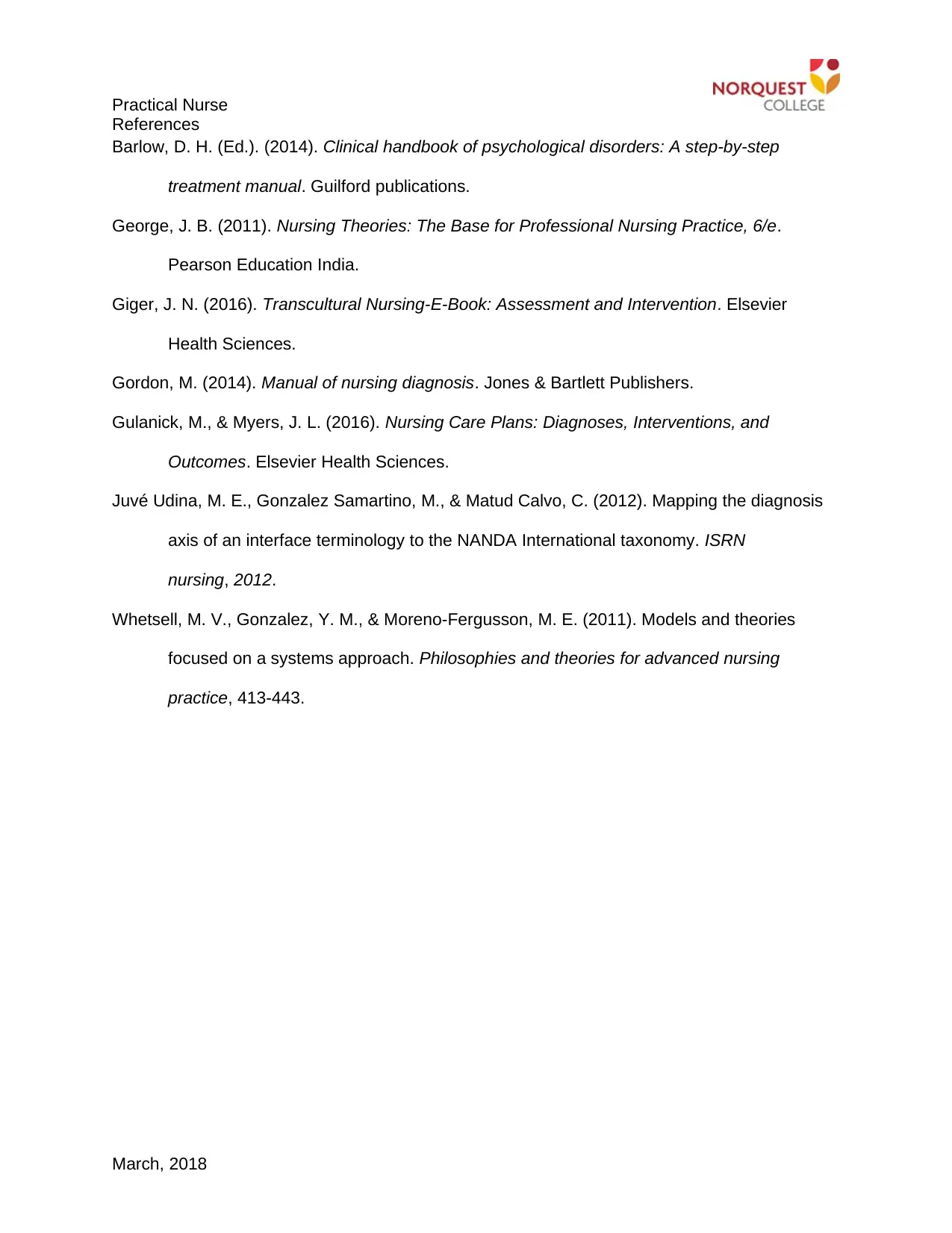NorQuest College Practical Nurse Care Plan Assignment Solution
VerifiedAdded on 2021/09/29
|4
|1058
|96
Practical Assignment
AI Summary
This document presents a Practical Nurse care plan template, focusing on a patient named Judy, a single mother with type 2 diabetes and anxiety. The assignment follows the metaparadigm framework, including person, environment, health, and nursing components. It identifies anxiety as the priority nursing diagnosis, related to Judy's inability to manage her responsibilities. The care plan includes nursing interventions such as assessing anxiety levels, developing coping skills, and identifying anxiety symptoms. The expected outcome is for Judy to effectively manage her responsibilities and reduce anxiety levels within a week. References are provided to support the plan.

Practical Nurse
NorQuest Care Plan Template Form
Name:
Chosen scenario (circle one): 1 2 3
Assessment
● All components of the metaparadigm
included
● Literature support provided
1. Person Component- this focuses more
on the person receiving care but also
include family members and other
groups that are important to the
patient (George, 2011). Judy who is a
single parent of two children is the
care receiver. She is from Ghana but
has live in Canada for four years.
Currently fond to eating more fast
food. She has gained 30 pounds has
difficulty in controlling her blood sugar.
2. Environment Component- comprises
of the patient surroundings, both
internal and external, which affects
her (George, 2011). Family
interactions, culture, economic
conditions and geographic locations
are part this component. In our case,
Judy skype her family once a week
since she lives far from them.
However, she doesn’t have any family
support.
3. Health Component- this component of
metaparadigms focuses on the extent
of wellness and the access of health
that the patient has (George, 2011). It
may comprise how person’s
emotional, physical, spiritual and
social well-being gets integrated in
health care. Judy was diagnosed type
2 diabetes and is finding it difficult to
control her blood sugar. Her Asthma is
well controlled. She however finds it
difficult to tackle all her responsibilities
and this make her very anxious.
4. Nursing Component- this comprises of
the care given to the patient for
optimal health through a relationship
that is mutual in an environment that
is safe and caring (George, 2011). It
applies the knowledge, skills,
teamwork and communication to
March, 2018
NorQuest Care Plan Template Form
Name:
Chosen scenario (circle one): 1 2 3
Assessment
● All components of the metaparadigm
included
● Literature support provided
1. Person Component- this focuses more
on the person receiving care but also
include family members and other
groups that are important to the
patient (George, 2011). Judy who is a
single parent of two children is the
care receiver. She is from Ghana but
has live in Canada for four years.
Currently fond to eating more fast
food. She has gained 30 pounds has
difficulty in controlling her blood sugar.
2. Environment Component- comprises
of the patient surroundings, both
internal and external, which affects
her (George, 2011). Family
interactions, culture, economic
conditions and geographic locations
are part this component. In our case,
Judy skype her family once a week
since she lives far from them.
However, she doesn’t have any family
support.
3. Health Component- this component of
metaparadigms focuses on the extent
of wellness and the access of health
that the patient has (George, 2011). It
may comprise how person’s
emotional, physical, spiritual and
social well-being gets integrated in
health care. Judy was diagnosed type
2 diabetes and is finding it difficult to
control her blood sugar. Her Asthma is
well controlled. She however finds it
difficult to tackle all her responsibilities
and this make her very anxious.
4. Nursing Component- this comprises of
the care given to the patient for
optimal health through a relationship
that is mutual in an environment that
is safe and caring (George, 2011). It
applies the knowledge, skills,
teamwork and communication to
March, 2018
Paraphrase This Document
Need a fresh take? Get an instant paraphrase of this document with our AI Paraphraser

Practical Nurse
obtain the best scenario in the health
outcome of the patient. For example,
Judy was diagnosed with Asthma in
her childhood but has been well
controlled and uses ventolin puffers
when needed.
First Diagnosis Anxiety (Juvé Udina, Gonzalez Samartino, &
Matud, 2012) related to inability to manage
her responsibilities as evident by the patient
feeling inadequate.
Second Diagnosis Risk for Unstable Blood Glucose (Gordon,
2014) related to deficient knowledge of
diabetes management.
Priority Diagnosis Identified
● Literature support provided
Anxiety (Juvé Udina, Gonzalez Samartino, &
Matud, 2012) related to inability to manage
her responsibilities as evident by the patient
feeling inadequate. This is a priority nursing
care for Judy since its getting hard for her to
balance her responsibilities left and this may
create confusion even in her day to day
activities. The health component of
metaparadigm is associated with this
diagnosis since it is concern with the wellness
of the client and may even extent to affect her
physical, emotional and social wellbeing
(Whetsell, Gonzalez, & Moreno-Fergusson, 2011).
If this diagnosis is not treated, then Judy’s
wellness will be altered. She will eventually
stop concentrating on her responsibilities and
may perform them poorly. Further
complications such as depression may also
develops.
Planning Judy to be able to develop positive coping
mechanisms and describe a reduction in the
anxiety level after a period of one week.
First Nursing Intervention
● Literature support provided
The nurse will assess the patient level of
anxiety every day (Giger, 2016). Mild anxiety
does not limit the patient’s awareness and
problem solving. Moderate anxiety may limit
environmental stimuli awareness and make it
difficult to solve problems. May need help
Severe anxiety lowers the ability to
comprehend information and solve problems.
The nurse should therefore determine where
Judy falls and help accordingly.
March, 2018
obtain the best scenario in the health
outcome of the patient. For example,
Judy was diagnosed with Asthma in
her childhood but has been well
controlled and uses ventolin puffers
when needed.
First Diagnosis Anxiety (Juvé Udina, Gonzalez Samartino, &
Matud, 2012) related to inability to manage
her responsibilities as evident by the patient
feeling inadequate.
Second Diagnosis Risk for Unstable Blood Glucose (Gordon,
2014) related to deficient knowledge of
diabetes management.
Priority Diagnosis Identified
● Literature support provided
Anxiety (Juvé Udina, Gonzalez Samartino, &
Matud, 2012) related to inability to manage
her responsibilities as evident by the patient
feeling inadequate. This is a priority nursing
care for Judy since its getting hard for her to
balance her responsibilities left and this may
create confusion even in her day to day
activities. The health component of
metaparadigm is associated with this
diagnosis since it is concern with the wellness
of the client and may even extent to affect her
physical, emotional and social wellbeing
(Whetsell, Gonzalez, & Moreno-Fergusson, 2011).
If this diagnosis is not treated, then Judy’s
wellness will be altered. She will eventually
stop concentrating on her responsibilities and
may perform them poorly. Further
complications such as depression may also
develops.
Planning Judy to be able to develop positive coping
mechanisms and describe a reduction in the
anxiety level after a period of one week.
First Nursing Intervention
● Literature support provided
The nurse will assess the patient level of
anxiety every day (Giger, 2016). Mild anxiety
does not limit the patient’s awareness and
problem solving. Moderate anxiety may limit
environmental stimuli awareness and make it
difficult to solve problems. May need help
Severe anxiety lowers the ability to
comprehend information and solve problems.
The nurse should therefore determine where
Judy falls and help accordingly.
March, 2018

Practical Nurse
Second Nursing Intervention
● Literature support provided
The nurse will help Judy to develop skills that
reduce anxiety like the use of self-reassuring
statements. These strategies will make the
patient gain confidence and sense of
personal mastery (Gulanick, & Myers, 2016).
The nurse should encourage Judy to use
such skills when performing her duties so that
she does not feel overwhelmed at any point.
Third Nursing Intervention
● Literature support provided
The nurse will assist the client in identifying
the symptoms of anxiety that is increasing
and seek options to curb anxiety from
immobilizing her. Early recognition of anxiety
symptoms will enable her to intervene quickly
when it is still at a lower level to manage her
anxiety (Barlow, 2014).. Judy can be able to
use the ability of problem solving more
effectively when the anxiety level is still low.
Evaluation The expected outcome will have been
achieved if by the end of one week, Judy will
be able to perform her responsibilities
effectively and can even verbalize that she
does not feel anxious anymore. Moreover, the
effectiveness of interventions will be
considered positive if Judy would have
developed appropriate anxiety reducing skills
and can used it whenever she feels anxious.
March, 2018
Second Nursing Intervention
● Literature support provided
The nurse will help Judy to develop skills that
reduce anxiety like the use of self-reassuring
statements. These strategies will make the
patient gain confidence and sense of
personal mastery (Gulanick, & Myers, 2016).
The nurse should encourage Judy to use
such skills when performing her duties so that
she does not feel overwhelmed at any point.
Third Nursing Intervention
● Literature support provided
The nurse will assist the client in identifying
the symptoms of anxiety that is increasing
and seek options to curb anxiety from
immobilizing her. Early recognition of anxiety
symptoms will enable her to intervene quickly
when it is still at a lower level to manage her
anxiety (Barlow, 2014).. Judy can be able to
use the ability of problem solving more
effectively when the anxiety level is still low.
Evaluation The expected outcome will have been
achieved if by the end of one week, Judy will
be able to perform her responsibilities
effectively and can even verbalize that she
does not feel anxious anymore. Moreover, the
effectiveness of interventions will be
considered positive if Judy would have
developed appropriate anxiety reducing skills
and can used it whenever she feels anxious.
March, 2018
⊘ This is a preview!⊘
Do you want full access?
Subscribe today to unlock all pages.

Trusted by 1+ million students worldwide

Practical Nurse
References
Barlow, D. H. (Ed.). (2014). Clinical handbook of psychological disorders: A step-by-step
treatment manual. Guilford publications.
George, J. B. (2011). Nursing Theories: The Base for Professional Nursing Practice, 6/e.
Pearson Education India.
Giger, J. N. (2016). Transcultural Nursing-E-Book: Assessment and Intervention. Elsevier
Health Sciences.
Gordon, M. (2014). Manual of nursing diagnosis. Jones & Bartlett Publishers.
Gulanick, M., & Myers, J. L. (2016). Nursing Care Plans: Diagnoses, Interventions, and
Outcomes. Elsevier Health Sciences.
Juvé Udina, M. E., Gonzalez Samartino, M., & Matud Calvo, C. (2012). Mapping the diagnosis
axis of an interface terminology to the NANDA International taxonomy. ISRN
nursing, 2012.
Whetsell, M. V., Gonzalez, Y. M., & Moreno-Fergusson, M. E. (2011). Models and theories
focused on a systems approach. Philosophies and theories for advanced nursing
practice, 413-443.
March, 2018
References
Barlow, D. H. (Ed.). (2014). Clinical handbook of psychological disorders: A step-by-step
treatment manual. Guilford publications.
George, J. B. (2011). Nursing Theories: The Base for Professional Nursing Practice, 6/e.
Pearson Education India.
Giger, J. N. (2016). Transcultural Nursing-E-Book: Assessment and Intervention. Elsevier
Health Sciences.
Gordon, M. (2014). Manual of nursing diagnosis. Jones & Bartlett Publishers.
Gulanick, M., & Myers, J. L. (2016). Nursing Care Plans: Diagnoses, Interventions, and
Outcomes. Elsevier Health Sciences.
Juvé Udina, M. E., Gonzalez Samartino, M., & Matud Calvo, C. (2012). Mapping the diagnosis
axis of an interface terminology to the NANDA International taxonomy. ISRN
nursing, 2012.
Whetsell, M. V., Gonzalez, Y. M., & Moreno-Fergusson, M. E. (2011). Models and theories
focused on a systems approach. Philosophies and theories for advanced nursing
practice, 413-443.
March, 2018
1 out of 4
Related Documents
Your All-in-One AI-Powered Toolkit for Academic Success.
+13062052269
info@desklib.com
Available 24*7 on WhatsApp / Email
![[object Object]](/_next/static/media/star-bottom.7253800d.svg)
Unlock your academic potential
Copyright © 2020–2025 A2Z Services. All Rights Reserved. Developed and managed by ZUCOL.




